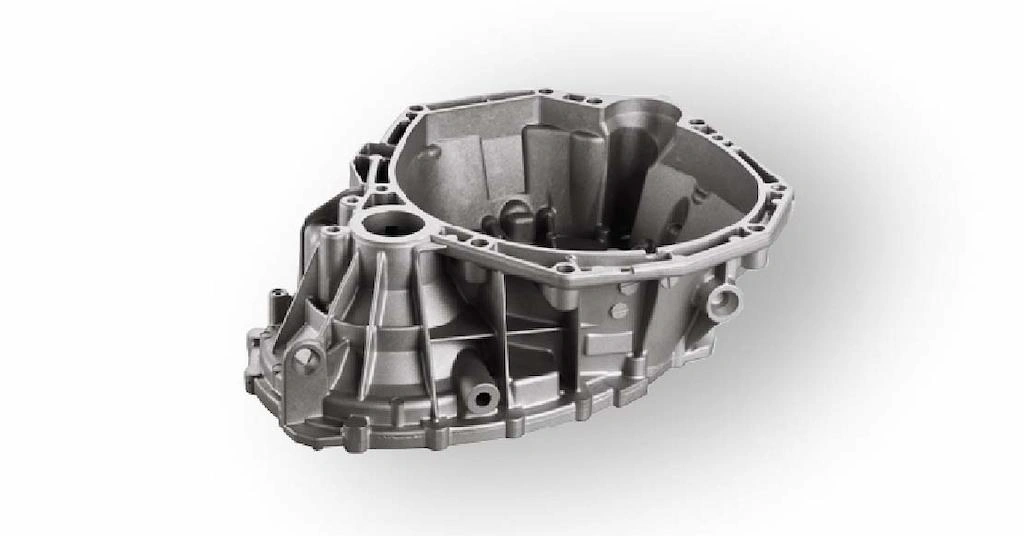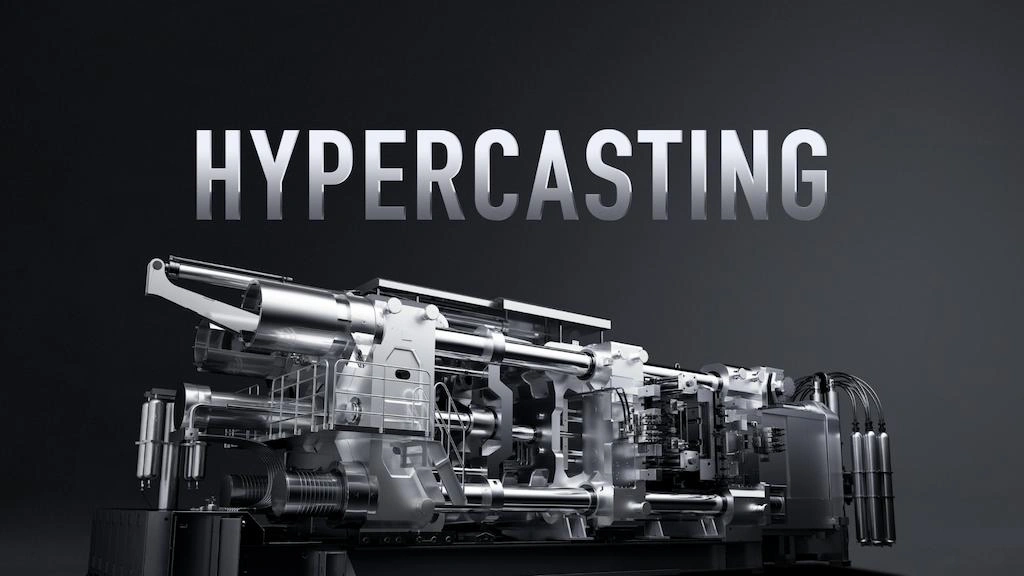
Die casting has been a prominent technology in automotive production, for complex and lightweight parts with high precision. The production speed, consistency, and finish quality make it favorable for diverse automotive die casting applications.
Technology itself is also evolving to meet innovations and standards in the automotive industry., Xiaomi Hypercasting is one such example. This process can merge multiple components into a single structure, which reduces the assembly requirements like welding and also improves structural integrity. For example, Xiaomi SU7 sedan parts like the rear underbody panel, structural elements, and battery housing are made with the new Xiaomi hypercasting machine.
This article will discuss automotive die casting in detail, including its importance in producing high-quality car parts. In the end, a case study of die casting parts in Xiaomi SU7.
Let’s get started!
Use of Die Casting in the Automotive Industry

High-pressure die casting
Die casting has had an important role in automotive from the beginning, over time their relations have developed as a prime method for automotive structural components. Although small components for vehicles were popular from the late 19th century, they became widely popular after the 20th.

Die casting parts of a car
Mercedes-Benzes, Volkswagen, BMW, General Motors, Toyota, Tesla, Ford Motors, and all major companies use automotive die casting techniques.
Now, let’s look at the die casting techniques used in automotive manufacturing;
- Hot Chamber Die Casting: The melting system and injection system are integrated into a single piece of equipment in this technique, which is suitable for metals with low melting temperatures like zinc and magnesium.
- Cold Chamber Die Casting: High melting point metals like aluminum alloys are melted in separate furnaces and injected into the mold.
- Gravity Die Casting: The “gravity” refers to no extra pressure during the pouring/injection of liquid material. It is suitable for medium-sized auto parts.
- High Pressure Die Casting: The high injection pressure is particularly suitable for complex automotive components like engine blocks. It provides a smooth finish and tight precision.
- Low-Pressure Die Casting: The slow pouring reduces the flow turbulence and minimizes defects, especially in large-size casting.
Try Prolean Now!
What Parts Are Made with Die Casting in a Car?
Die casting makes numerous parts for a car, from structural items and engine components to interiors. Different materials are used in automotive die casting based on the requirement of particular components. Aluminum alloys are one of the common choices due to their lightweight properties, at the same time offering good strength and durability.
Engine Components

Die casting engine part
The engine components are critical in the performance of a car, that needs to robust, accurate, and must withstand extreme thermal conditions. Die casting of aluminum alloys like AA2618 and AA4032 can fulfill these requirements.
Examples: Cylinder head, Engine block, Crankcase, and Oil Pan
Transmission Parts

Transmission case
Die-cast transmission parts for the powertrain provide both toughness and lighting for smooth power delivery between components. Typically, aluminum and magnesium alloys are cast for transmission parts.
Examples: Gearbox housings, transmission cases, and torque converter parts.
Braking System

Automotive brake parts
Braking and safety system components need to have high strength, precision, and durability.
Aluminum and magnesium die casting create lightweight components that improve vehicle performance while maintaining structural integrity. Consequently, it also allows for complex designs, accommodating critical safety features like anti-lock braking and load-bearing mechanisms.
Examples: Brake calipers, Anti-lock braking system (ABS) housings, Seatbelt retractors, Electronic stability control (ESC) housings, Parking brake components, etc.
Steering Components

Steering knuckle
Die casting companies make several steering and suspension parts for high-performance vehicles, including cars. It allows them to create lightweight yet strong components, which enhance performance by reducing overall vehicle weight while maintaining structural integrity.
Examples: Power steering housings, Steering knuckles, Control arms, Suspension brackets, Crossmembers, etc.
Interior and Exterior Components
Automotive die casting applications for Interior and exterior features benefit from aesthetics and durability. The die casting parts provide a smooth surface and are compatible with many finishing methods.
Examples: Dashboard panels, control levers, door handles, and trim elements.
Thermal Management and Electrical Items
Copper, brass, and other conductive metals are die-casted to make a thermal management system for cars. Heat sinks, radiator tanks, and air conditioning compressor housings are a few examples of that.
Net, housing of car’s electrical and electronics sensors are also made with die casting. For example, electronic control units, sensors, and connector housings.
What is a Die Cast Car?
Next, let’s understand “What is a die cast car?”, it is a representation copy of an actual car or toy. This miniature model of the vehicle includes the exact features of a real car, such as doors, window linings, hood, interiors, steering, etc.

The sizing of these cars die cast cars involves a fixed proportion, typically 1:18 to 1:64, or any other custom ratio. Automotive die casting for these kinds of replicas is useful for research, education, training, or artistic collection purposes.
Using New Casting Technology in Automotive: A Case Study of Xiaomi SU7
How die casting has been more efficient and beneficial in manufacturing than ever with a case study of the newly released Xiaomi SU7 EV. A lot of parts of this sedan are made with advanced Xiaomi hypercasting technology.
Background
As the EV market is growing significantly around the globe, manufacturers are innovating new die-casting technologies and methods to replace the old methods, so they can increase the part’s accuracy, consistency, and production speeds.
High-pressure die casting, semi-solid casting, and hypercasting are three major techniques that are trending in manufacturing. Let’s look at how hypercasting is used in SU7 to meet the increasing demand for lightweight and complex components for overall efficiency and sustainability.
Hypercasting Adaptation in Xiaomi SU7’s
Xiaomi has used its own hypercasting system to produce diverse components of SU7. The system consists of a 9,100-ton pressure capability, which is higher than Tesla’s 9000-ton machines. It allows Xiaomi to cast over 72 individual car parts within a single die casting process.
Unlike sand or pressure casting, it makes a single large component like a rear floor assembly. Additionally, the rapid cooling and solidifications are done with advanced control systems, allowing for high strength and accuracy.

Hypercasting
Xiaomi casting technology also includes AI integration in the selection of the best material composition and the quality control of die-casted products. This is a strong factor behind vehicle reliability. Subsequently, it reduces more than 800 welding points compared to the traditional car-making approach.
The components of SU7 made with hypercasting are;
- Rear floor assembly
- Chassis frame
- Battery Housing
- Structural Beams
- CrossMembers
Performance and Efficiency Gains
The advancement of the casting method directly contributes to the durability, performance, and aesthetic of the SU7, making it one of the most popular sedan cars in the market.
| Performance/ Efficiency Gain | Description | Impact |
| Weight Reduction | Structural weight was reduced by 17% with advanced alloys. | High energy efficiency and driving range (600 km +) |
| Streamlined Manufacturing | Casts 72 parts into one; reduces 800+ welding points. | Manufacturing time cut to 100 seconds |
| Enhanced Durability | Lifespan over 2 million + Kilometers | Lower maintenance and replacement costs. |
| Noise and Vibration Control | Unified design reduces road noise by 2 dB. | Smooth and comfortable ride |
| Energy Efficiency in Production | Fewer production steps; lower energy consumption. | Higher manufacturing sustainability |
Findings of Case Study
The use of hypercasting in Xiaomi SU7 showcases how large-scale integration advances EV production. As demand for EVs increases, this innovative casting technology has made it possible to produce lightweight, cost-effective, and durable vehicles at competitive prices.
Try Prolean Now!
Importance of Die Casting in Automotive Applications
Die casting creates lightweight parts with intricate detailing, it not only improves the fuel efficiency and emission, but also manufacturing cost and environmental impacts.
Automotive die casting parts
The following are the die casting’s importance in the automotive industry;
- Fuel Efficiency: The use of aluminum and magnesium alloys reduces weight which leads to better fuel efficiency.
- Extended Lifespan: The die-cast automotive components provide excellent dimensional stability and withstand all harsh conditions, extending the lifespan of the vehicle.
- Complex Parts: You can make custom and intricate designs with automotive die casting, which streamlines the assembly process.
- Cost Benefit: The die casting produces a large number of parts with a single die. It also reduces the material wastage. These two reasons make it highly cost-effective.
- Thermal Systems in EVs: As electric vehicles (EVs) become more prevalent, die casting produces components like battery casings and thermal management systems.
Are you Looking for Die Casting Automotive Parts?
The high-strength and durable automotive casting requires expertise and equipment. At Proleantech, we have high-pressure die-casting machines along with other different casting equipment. They are capable of achieving tight tolerances and are compatible with aluminum, magnesium, copper, and other materials.
✓ 150 to 1200 bars
✓ Injection Speed Up to 500 km/h
✓ 20+ Metal and Alloy Options
✓ Smooth Finish
✓Desing and Manufacturability Consultation
✓ Cost Optimization for Prototyping and Small Projects
For any die casting service, you can upload your design and request a quote in our online portal. Our engineers will get back to you with an accurate estimation and additional information.
FAQs
What are the casting methods for automotive parts?
The automotive industry uses different casting methods to produce vehicle parts, die casting, investment casting, sand casting, etc. Among these, die casting is popular for the production of precise and complex auto parts in large volumes.
What metals are used in automotive die casting?
Aluminum, magnesium, zinc, and their alloys are the most common materials in die casting of automotive components. They are favored due to their lightweight, strength, corrosion resistance, and long life.
Which vehicle components can be made with die casting?
Die casting is ideal for making automotive components like engine blocks, cylinder heads, brake parts, door handles, mirror housings, etc.




0 Comments